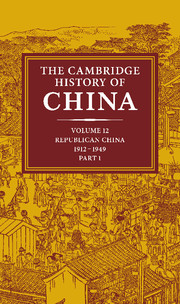Book contents
- Frontmatter
- 1 Introduction: Maritime and continental in China's history
- 2 Economic trends, 1912–49
- 3 The foreign presence in China
- 4 Politics in the aftermath of revolution: the era of Yuan Shih-k'ai, 1912–16
- 5 A constitutional republic: the Peking government, 1916–28
- 6 The warlord era: politics and militarism under the Peking government, 1916–28
- 7 Intellectual change: from the Reform movement to the May Fourth movement, 1895–1920
- 8 Themes in intellectual history: May Fourth and after
- 9 Literary trends I: the quest for modernity, 1895–1927
- 10 The Chinese Communist Movement to 1927
- 11 The Nationalist Revolution: from Canton to Nanking, 1923–28
- 12 The Chinese bourgeoisie, 1911–37
- Bibliographical essay
- Bibliography
- Index
- Republican China – physical features
- References
9 - Literary trends I: the quest for modernity, 1895–1927
Published online by Cambridge University Press: 28 March 2008
- Frontmatter
- 1 Introduction: Maritime and continental in China's history
- 2 Economic trends, 1912–49
- 3 The foreign presence in China
- 4 Politics in the aftermath of revolution: the era of Yuan Shih-k'ai, 1912–16
- 5 A constitutional republic: the Peking government, 1916–28
- 6 The warlord era: politics and militarism under the Peking government, 1916–28
- 7 Intellectual change: from the Reform movement to the May Fourth movement, 1895–1920
- 8 Themes in intellectual history: May Fourth and after
- 9 Literary trends I: the quest for modernity, 1895–1927
- 10 The Chinese Communist Movement to 1927
- 11 The Nationalist Revolution: from Canton to Nanking, 1923–28
- 12 The Chinese bourgeoisie, 1911–37
- Bibliographical essay
- Bibliography
- Index
- Republican China – physical features
- References
Summary
In a seminal essay on modern Chinese literature, Professor C. T. Hsia delineates a ‘moral burden’ which tends to overhang the entire corpus of literary creation in the first half of the twentieth century. ‘What distinguishes this modern phase of Chinese literature’, Professor Hsia remarks, is its ‘obsessive concern with China as a nation afflicted with a spiritual disease and therefore unable to strengthen itself or change its set ways of inhumanity.’ This ‘patriotic passion’, which enkindles all the major writers of the period, also produces in Hsia's view, ‘a certain patriotic provinciality’: ‘the Chinese writer sees the conditions of China as peculiarly Chinese and not applicable elsewhere.’ It is this obsession that dictates, in turn, a general preoccupation with content, rather than form, and a preponderance of ‘realism’ – as the modern Chinese writer's effort to make some sense of the socio-political chaos in his immediate environment. The study of modern Chinese literature is, therefore, burdened with China's modern history, and a generally historical approach – with due regard to intrinsic literary concerns – is both imperative and inevitable.
From a historical perspective, the theme of ‘obsession with China’ contains at least three major variations which may be regarded as further hallmarks of modern Chinese literature. First, the moral vision of China ‘as a nation afflicted with spiritual disease’ creates a sharp polarity between tradition and modernity: the disease is rooted in Chinese tradition, whereas modernity means essentially an iconoclastic revolt against this tradition and an intellectual quest for new solutions.
Keywords
- Type
- Chapter
- Information
- The Cambridge History of China , pp. 451 - 504Publisher: Cambridge University PressPrint publication year: 1983
References
- 1
- Cited by

